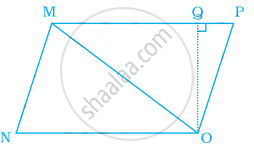Advertisements
Advertisements
Question
PQRS is a parallelogram (see the given figure). QM is the height from Q to SR and QN is the height from Q to PS. If SR = 12 cm and QM = 7.6 cm. Find:
- the area of the parallelogram PQRS
- QN, if PS = 8 cm

Solution
a. Area of parallelogram = Base × Height
= SR × QM
= 7.6 × 12
= 91.2 cm2
b. Area of parallelogram = Base × Height
91.2 cm2 = PS × QN
QN × 8 = 91.2
QN = `91.2/8`
QN = 11.4 cm
APPEARS IN
RELATED QUESTIONS
Find the missing value:
| Base | Height | Area of parallelogram |
| 20 cm | ______ | 246 cm2 |
Area of a parallelogram is 83.2 sq cm. If its height is 6.4 cm, find the length of its base.
A parallelogram has sides of 15 cm and 12 cm; if the distance between the 15 cm sides is 6 cm; find the distance between 12 cm sides.
A ground is in the shape of parallelogram. The height of the parallelogram is 14 metres and the corresponding base is 8 metres longer than its height. Find the cost of levelling the ground at the rate of ₹ 15 per sq.m
In a parallelogram the base is three times its height. If the height is 8 cm then the area is
An agricultural field is in the form of a parallelogram, whose area is 68.75 sq.hm. The distance between the parallel sides is 6.25 cm. Find the length of the base
The height of the parallelogram is one-fourth of its base. If the area of the parallelogram is 676 sq.cm, find the height and the base
Find the height of the parallelogram whose base is four times the height and whose area is 576 sq.cm
Ratio of area of ∆MNO to the area of parallelogram MNOP in the same figure is ______.

If perimeter of two parallelograms are equal, then their areas are also equal.
